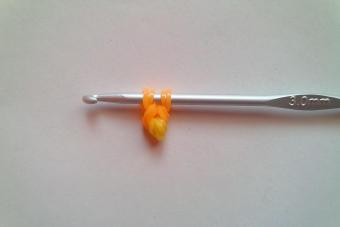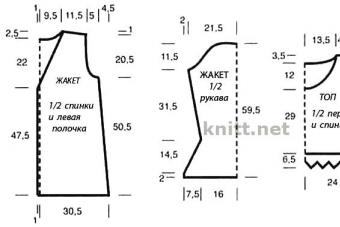The table shows the thermophysical properties of copper depending on the temperature in the range from 50 to 1600 degrees Kelvin.
The density of copper is 8933 kg / m 3 (or 8.93 g / cm 3) at room temperature. Copper is almost four times heavier and. These metals will float on the surface of liquid copper. The copper density values in the table are indicated in the unit of kg/m 3 .
The dependence of the density of copper on its temperature is presented in the table. It should be noted that the density of copper during its heating decreases both in solid metal and in liquid copper. The decrease in the value of the density of this metal is due to its expansion when heated - the volume of copper increases. It should be noted that liquid copper has a density of about 8000 kg / m 3 at temperatures up to 1300°C.
The thermal conductivity of copper is 401 W / (m deg) at room temperature, which is a rather high value that is comparable to .
At 1357K (1084°C), copper passes into a liquid state, which is reflected in the table by a sharp drop in the value of the thermal conductivity of copper. It's clear that the thermal conductivity of liquid copper is almost two times lower than that of solid metal.
The thermal conductivity of copper tends to decrease when it is heated, however, at temperatures above 1400 K, the thermal conductivity value begins to increase again.
The table discusses the following thermophysical properties of copper at various temperatures:
- copper density, kg/m 3 ;
- specific heat capacity, J/(kg deg);
- thermal diffusivity, m 2 /s;
- thermal conductivity of copper, W/(m K);
- Lorentz function;
- heat capacity ratio.
Thermal properties of copper: CTE and specific heat capacity of copper
Copper has relatively high melting and boiling heats: the specific heat of melting of copper is 213 kJ/kg; the specific heat of boiling of copper is 4800 kJ/kg.
The table below shows some of the thermophysical properties of copper depending on the temperature in the range from 83 to 1473K. Copper property values are given at normal atmospheric pressure. It should be noted that specific heat capacity of copper is 381 J/(kg deg) at room temperature, and the thermal conductivity of copper is 395 W/(m deg) at 20°C.
From the values of the coefficient of thermal expansion and heat capacity of copper in the table, it can be seen that the heating of this metal leads to an increase in these values. For example, the heat capacity of copper at a temperature of 900°C becomes equal to 482 J/(kg deg).
The table gives the following thermophysical properties of copper:
- copper density, kg/m 3 ;
- specific heat capacity of copper, kJ/(kg K);
- coefficient of thermal conductivity of copper, W/(m deg);
- electrical resistivity, Ohm m;
- linear coefficient of thermal expansion (KTE), 1/deg.
Sources:
1.
2. .
Today, many complex structures and devices have been developed that use metals and their alloys with different properties. In order to apply the most suitable alloy in a particular design, designers select it in accordance with the requirements of strength, fluidity, elasticity, etc., as well as the stability of these characteristics in the required temperature range. Next, the required amount of metal is calculated, which is required for the production of products from it. To do this, you need to calculate based on its specific gravity. This value is constant - this is one of the main characteristics of metals and alloys, which practically coincides with density. Calculating it is simple: you need to divide the weight (P) of a piece of metal in solid form by its volume (V). The resulting value is denoted γ, and it is measured in Newtons per cubic meter.
Specific Gravity Formula:
Based on the fact that weight is mass multiplied by the acceleration of free fall, we get the following:
Now about the units of measurement of specific gravity. The above Newtons per cubic meter refer to the SI system. If the CGS metric system is used, then this value is measured in dynes per cubic centimeter. In the MKSS system, the following unit is used to designate specific gravity: kilogram-force per cubic meter. Sometimes it is acceptable to use gram-force per cubic centimeter - this unit lies outside all metric systems. The main ratios are obtained as follows:
1 dyne / cm 3 \u003d 1.02 kg / m 3 \u003d 10 n / m 3.
The higher the specific gravity, the heavier the metal. For light aluminum, this value is quite small - in SI units it is 2.69808 g / cm 3 (for example, for steel it is 7.9 g / cm 3). Aluminum, as well as its alloys, is in high demand today, and its production is constantly growing. After all, this is one of the few metals needed for industry, the supply of which is in the earth's crust. Knowing the specific gravity of aluminum, you can calculate any product from it. To do this, there is a convenient metal calculator, or you can manually calculate by taking the values of the specific gravity of the desired aluminum alloy from the table below.
However, it is important to consider that this is the theoretical weight of rolled products, since the content of additives in the alloy is not strictly defined and can vary within small limits, then the weight of rolled products of the same length, but different manufacturers or batches may differ, of course this difference is small, but it exists.
Here are some calculation examples:
Example 1. Calculate the weight of A97 aluminum wire with a diameter of 4 mm and a length of 2100 meters.
Let's determine the cross-sectional area of the circle S \u003d πR 2 means S \u003d 3.1415 2 2 \u003d 12.56 cm 2
Let's determine the weight of rolled products knowing that the specific gravity of the brand A97 \u003d 2.71 g / cm 3
M \u003d 12.56 2.71 2100 \u003d 71478.96 grams \u003d 71.47 kg
Total wire weight 71.47 kg
Example 2. We calculate the weight of a circle made of aluminum grade AL8 with a diameter of 60 mm and a length of 150 cm in the amount of 24 pieces.
Let's determine the cross-sectional area of the circle S \u003d πR 2 means S \u003d 3.1415 3 2 \u003d 28.26 cm 2
We determine the weight of rolled products knowing that the specific gravity of the brand AL8 \u003d 2.55 g / cm 3
The table shows the density of metals and alloys, as well as the coefficient TO the ratio of their density to . The density of metals and alloys in the table is indicated in units of g/cm 3 for the temperature range from 0 to 50°C.
Given the density of metals, such as: beryllium Be, vanadium V, bismuth Bi, gallium Ga, hafnium Hf, germanium Ge, indium In, cadmium Cd, cobalt Co, palladium Pd, platinum Pt, rhenium Re, rhodium Rh, rubidium Rb, ruthenium Ru, Ag, strontium Sr , antimony Sb, thallium Tl, tantalum Ta, tellurium Te, chromium Cr, zirconium Zr.
Density of aluminum alloys and metal chips:: AL1, AL2, AL3, AL4, AL5, AL7, AL8, AL9, AL11, AL13, AL21, AL22, AL24, AL25. Bulk chip density: small crushed aluminum chips, fine steel chips, coarse steel chips, cast iron chips. Note: chip density in the table is given in units of t/m 3 .
Density of magnesium and copper alloys: wrought magnesium alloys: MA1, MA2, MA2-1, MA8, MA14; foundry magnesium alloys: ML3, ML4, ML6, ML10, ML11, ML12; copper-zinc alloys () foundry: LTs16K4, LTs23A6Zh3Mts2, LTs30A3, LTs38Mts2S2, LTs40Sd, LTs40S, LTs40 Mts3Zh, LTs25S2; pressure-treated copper-zinc alloys: L96, L90, L85, L80, L70, L68, L63, L60, LA77-2, LAZH60-1-1, LAN59-3-2, LZhMts59-1-1, LN65-5, LM-58-2, LM-A57-3-1.
Density of bronze of various grades: tinless, pressure-treated: BrA5, 7, BrAMts9-2, BrAZh9-4, BrAZhMts10-3-1.5, BrAZhN10-4-4, BrKMts3.1, BrKN1-3, BrMts5; beryllium bronzes: BrB2, BrBNT1.9, BrBNT1.7; deformable tin bronzes: Br0F8.0-0.3, Br0F7-0.2, Br0F6.5-0.4, Br0F6.5-0.15, Br0F4-0.25, Br0Ts4-3, Br0TsS4-4-2, 5, Br0CS4-4-4; tin casting bronzes: Br03Ts12S5, Br03Ts7S5N1, Br05Ts5S5; tinless foundry bronzes: BrA9Mts2L, BrA9Zh3L, BrA10Zh4N4L, BrS30.
Density of nickel and zinc alloys: processed by pressure: NK0.2, NMts2.5, NMts5, NMtsAK2-2-1, NX9.5, MNMts43-0.5, NMTs-40-1.5, MNZHMts30-1-1, MNZH5-1, MN19, 16, MNTs15-20, MNA 13-3, MNA6-1.5, MNMts3-12; antifriction zinc alloys: TsAM9-1.5L, TsAM9-1.5, TsAM10-5L, TsAM10-5.
Density of steel, cast iron and babbits:, steel casting, high-speed steel with a tungsten content of 5 ... 18%; anti-friction cast iron, malleable and high-strength, gray cast iron; tin and lead babbits: B88, 83, 83S, B16, BN, BS6.
Let us give illustrative examples of the density of various metals and alloys. According to the table, it is clear that Lithium has the lowest density, it is considered the lightest metal, the density of which is even less - the density of this metal is 0.53 g / cm 3 or 530 kg / m 3. What metal has the highest density? The metal with the highest density is osmium. The density of this rare metal is 22.59 g / cm 3 or 22590 kg / m 3.
It should also be noted the rather high density of precious metals. For example, the density of such heavy metals as gold is 21.5 and 19.3 g/cm 3 respectively. Additional information on the density and melting point of metals is presented in.
Alloys also have a wide range of densities. Light alloys include magnesium alloys and aluminum alloys. The density of aluminum alloys is higher. High-density alloys include copper alloys such as brass and bronze, as well as babbits.
The density of copper (pure), the surface of which has a reddish, and in a break pinkish hue, is high. Accordingly, this metal also has a significant specific gravity. Due to its unique properties, primarily its excellent electrical and electrical properties, copper is actively used for the production of elements of electronic and electrical systems, as well as products for other purposes. In addition to pure copper, its minerals are of great importance for many industries. Despite the fact that there are more than 170 types of such minerals in nature, only 17 of them have found active use.
Copper Density Value
The density of this metal, which can be viewed in a special table, has a value equal to 8.93 * 10 3 kg / m 3. Also in the table you can see another, no less important than the density, characteristic of copper: its specific gravity, which is also 8.93, but measured in grams per cm 3. As you can see, for copper, the value of this parameter coincides with the density value, but you should not think that this is typical for all metals.
The density of this, and any other metal, measured in kg / m 3, directly affects the mass of products made from this material. But to determine the mass of a future product made of copper or its alloys, for example, brass, it is more convenient to use the value of their specific gravity, rather than density.
Specific Gravity Calculation
To date, many methods and algorithms have been developed for measuring and calculating not only density, but also specific gravity, which make it possible to determine this important parameter even without the help of tables. Knowing the specific gravity, which differs for different and pure metals, as well as the density value, it is possible to effectively select materials for the production of parts with specified parameters. It is very important to carry out such measures at the design stage of devices in which it is planned to use parts made of copper and its alloys.
Specific gravity, the value of which (as well as density) can also be viewed in the table, is the ratio of the weight of a product made both from metal and from any other homogeneous material to its volume. This ratio is expressed by the formula γ=P/V, where the letter γ denotes the specific gravity.
Specific gravity and density should not be confused, which are inherently different characteristics of the metal, although they have the same value for copper.
Knowing the specific gravity of copper and using the formula for calculating this value γ=P/V, it is possible to determine the mass of a copper billet having a different cross section. To do this, it is necessary to multiply the value of the specific gravity for copper and the volume of the workpiece in question, which is not particularly difficult to determine by calculation.
Specific Gravity Units
Different units are used to express the specific gravity of copper in different measurement systems.
- In the CGS system, this parameter is measured in 1 dyne / cm 3.
- In the SI system, the unit of measurement is 1n / m 3.
- The MKSS system uses the unit of measurement 1 kg/m 3 .
If you are faced with different units of measurement for this parameter of copper or its alloys, then it is not difficult to convert them into each other. To do this, you can use a simple conversion formula, which looks like this: 0.1 dyne / cm 3 \u003d 1 n / m 3 \u003d 0.102 kg / m 3.

Weight Calculation Using Specific Gravity Value
To calculate the weight of a workpiece, you need to determine its cross-sectional area, and then multiply it by the length of the part and by the specific gravity.
Example 1:Let us calculate the weight of a bar made of copper-nickel alloy MNZh5-1, the diameter of which is 30 millimeters and the length is 50 meters.
The cross-sectional area is calculated by the formula S \u003d πR 2, therefore: S \u003d 3.1415 15 2 \u003d 706.84 mm 2 \u003d 7.068 cm 2
Knowing the specific gravity of the copper-nickel alloy MNZh5-1, which is 8.7 g / cm 3, we get: M \u003d 7.068 8.7 5000 \u003d 307458 grams \u003d 307.458 kg
Example 2Let us calculate the weight of 28 sheets of copper alloy M2, the thickness of which is 6 mm, and the dimensions are 1500x2000 mm.
The volume of one sheet will be: V \u003d 6 1500 2000 \u003d 18000000 mm 3 \u003d 18000 cm 3
Now, knowing that the specific gravity of 1 cm 3 of M3 grade copper is 8.94 g / cm 3, we can find out the weight of one sheet: M \u003d 8.94 18000 \u003d 160920 g \u003d 160.92 kg
The mass of all 28 rolled sheets will be: M = 160.92 28 = 4505.76 kg
Example 3:Let us calculate the weight of a square section rod made of copper alloy BrNKhK with a length of 8 meters and a side size of 30 mm.
Let's determine the volume of all rolled products: V \u003d 3 3 800 \u003d 7200 cm 3
The specific gravity of the specified heat-resistant alloy is 8.85 g / cm 3, therefore the total weight of the rolled products will be: M \u003d 7200 8.85 \u003d 63720 grams \u003d 63.72 kg
All metals have certain physical and mechanical properties, which, in fact, determine their specific gravity. To determine how one or another alloy of black or stainless steel is suitable for production, the specific weight of rolled metal is calculated. All metal products that have the same volume, but are made from different metals, for example, from iron, brass or aluminum, have a different mass, which is directly dependent on its volume. In other words, the ratio of the volume of the alloy to its mass - the specific density (kg / m3), is a constant value that will be characteristic of a given substance. The density of the alloy is calculated using a special formula and is directly related to the calculation of the specific gravity of the metal.
The specific gravity of a metal is the ratio of the weight of a homogeneous body of this substance to the volume of the metal, i.e. this is the density, in reference books it is measured in kg / m3 or g / cm3. From here you can calculate the formula for how to find out the weight of the metal. To find this, you need to multiply the reference value of the density by the volume.
The table gives the density of non-ferrous and black iron metals. The table is divided into groups of metals and alloys, where under each name the grade according to GOST and the corresponding density in g / cm3 are indicated, depending on the melting temperature. To determine the physical value of the specific density in kg / m3, you need to multiply the tabular value in g / cm3 by 1000. For example, this way you can find out what is the density of iron - 7850 kg / m3.
The most typical ferrous metal is iron. The density value - 7.85 g/cm3 can be considered as the specific gravity of ferrous metal based on iron. Ferrous metals in the table include iron, manganese, titanium, nickel, chromium, vanadium, tungsten, molybdenum, and ferrous alloys based on them, for example, stainless steels (density 7.7-8.0 g / cm3), ferrous steels ( density 7.85 g/cm3) cast iron (density 7.0-7.3 g/cm3) is mainly used. The remaining metals are considered non-ferrous, as well as alloys based on them. Non-ferrous metals in the table include the following types:
− light - magnesium, aluminum;
− noble metals (precious) - platinum, gold, silver and semi-precious copper;
− fusible metals – zinc, tin, lead.
Specific gravity of non-ferrous metals
|
Table. Specific gravity of metals, properties, designations of metals, melting point |
|||
| Name of metal, designation |
Atomic weight | Melting point, °C | Specific gravity, g / cc |
| Zinc Zn (Zinc) | 65,37 | 419,5 | 7,13 |
| Aluminum Al (Aluminium) | 26,9815 | 659 | 2,69808 |
| Lead Pb (Lead) | 207,19 | 327,4 | 11,337 |
| Tin Sn (Tin) | 118,69 | 231,9 | 7,29 |
| Copper Cu (Copper) | 63,54 | 1083 | 8,96 |
| Titanium Ti (Titanium) | 47,90 | 1668 | 4,505 |
| Nickel Ni (Nickel) | 58,71 | 1455 | 8,91 |
| Magnesium Mg (Magnesium) | 24 | 650 | 1,74 |
| Vanadium V (Vanadium) | 6 | 1900 | 6,11 |
| Tungsten W (Wolframium) | 184 | 3422 | 19,3 |
| Chrome Cr (Chromium) | 51,996 | 1765 | 7,19 |
| Molybdenum Mo (Molybdaenum) | 92 | 2622 | 10,22 |
| Silver Ag (Argentum) | 107,9 | 1000 | 10,5 |
| Tantalum Ta (Tantal) | 180 | 3269 | 16,65 |
| Iron Fe (Iron) | 55,85 | 1535 | 7,85 |
| Gold Au (Aurum) | 197 | 1095 | 19,32 |
| Platinum Pt (Platina) | 194,8 | 1760 | 21,45 |
When rolling blanks from non-ferrous metals, it is still necessary to know them exactly chemical composition, since their physical properties depend on it.
For example, if aluminum contains impurities (at least within 1%) of silicon or iron, then the plastic characteristics of such a metal will be much worse.
Another requirement for hot rolling of non-ferrous metals is the extremely accurate temperature control of the metal. For example, zinc requires a temperature of strictly 180 degrees during rolling - if it is slightly higher or slightly lower, the capricious metal will sharply lose its plasticity.
Copper is more "loyal" to temperature (it can be rolled at 850 - 900 degrees), but it requires an oxidizing (with a high oxygen content) atmosphere in the melting furnace - otherwise it becomes brittle.
Table of specific gravity of metal alloys
The specific gravity of metals is most often determined in the laboratory, but in its pure form they are very rarely used in construction. The use of non-ferrous metal alloys and ferrous metal alloys is much more common, which are divided into light and heavy according to their specific gravity.
Light alloys are actively used by modern industry due to their high strength and good high-temperature mechanical properties. The main metals of such alloys are titanium, aluminum, magnesium and beryllium. But alloys based on magnesium and aluminum cannot be used in aggressive environments and at high temperatures.
Heavy alloys are based on copper, tin, zinc, and lead. Among the heavy alloys in many industries, bronze is used (an alloy of copper with aluminum, an alloy of copper with tin, manganese or iron) and brass (an alloy of zinc and copper). Architectural details and sanitary fittings are produced from these grades of alloys.
The reference table below shows the main qualitative characteristics and specific gravity of the most common metal alloys. The list contains data on the density of the main metal alloys at an ambient temperature of 20°C.
|
List of metal alloys |
Density of alloys |
|
Admiralty brass - Admiralty Brass (30% zinc, and 1% tin) |
8525 |
|
Aluminum bronze - Aluminum Bronze (3-10% aluminum) |
7700 - 8700 |
|
Babbit - Antifriction metal |
9130 -10600 |
|
Beryllium bronze (beryllium copper) - Beryllium Copper |
8100 - 8250 |
|
Delta metal - Wikiwand Delta metal |
8600 |
|
Yellow Brass - Yellow Brass |
8470 |
|
Phosphor bronzes - Bronze - phosphorous |
8780 - 8920 |
|
Ordinary Bronzes - Bronze (8-14% Sn) |
7400 - 8900 |
|
Inconel - Inconel |
8497 |
|
Incoloy - Incoloy |
8027 |
|
Malleable Iron - Wrought Iron |
7750 |
|
Red brass (little zinc) - Red Brass |
8746 |
|
Brass, casting - Brass - casting |
8400 - 8700 |
|
Brass , rolled - Brass - rolled and drawn |
8430 - 8730 |
|
Lungs alloys aluminum - Light alloy based on Al |
2560 - 2800 |
|
Lungs alloys magnesium - Light alloy based on Mg |
1760 - 1870 |
|
Manganese Bronze - Manganese Bronze |
8359 |
|
Melchior - Cupronickel |
8940 |
|
Monel - Monel |
8360 - 8840 |
|
Stainless steel - Stainless Steel |
7480 - 8000 |
|
Nickel silver - Nickel silver |
8400 - 8900 |
|
Solder 50% tin/ 50% lead - Solder 50/50 Sn Pb |
8885 |
|
Light-colored anti-friction alloy for pouring bearings = |
7100 |
|
Lead bronzes, Bronze - lead |
7700 - 8700 |
|
Carbon steel - Steel |
7850 |
|
Hastelloy - Hastelloy |
9245 |
|
Cast iron - Cast iron |
6800 - 7800 |
|
Electrum (gold-silver alloy, 20% Au) - Electrum |
8400 - 8900 |
The density of metals and alloys presented in the table will help you calculate the weight of the product. The technique for calculating the mass of a part is to calculate its volume, which is then multiplied by the density of the material from which it is made. Density is the mass of one cubic centimeter or cubic meter of a metal or alloy. The mass values calculated on the calculator using formulas may differ from the real ones by several percent. This is not because the formulas are not exact, but because in life everything is a little more complicated than in mathematics: right angles are not quite right, a circle and a sphere are not ideal, deformation of the workpiece during bending, chasing and punching leads to uneven thickness , and you can list a bunch of other deviations from the ideal. The final blow to our commitment to precision comes from grinding and polishing, which results in unpredictable weight loss. Therefore, the values obtained should be treated as indicative.





